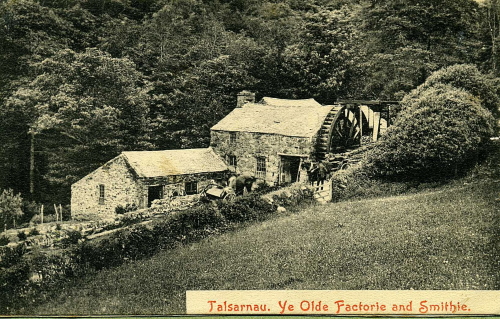There was a smithy at the Ynys at one time it was called Efail yr Ynys and I think it was where Minafon is now. There was another one at Llandecwyn and that was called yr Efail Fach and that was where they built the Wesleyan Chapel, Brontecwyn.
 Wmffra Lloyd had a smithy at Eisingrug, I have heard the old people talking about Efail Pengarreg, that must be the one where the cattle were shod before they started on their journey to the market in England as there was a place there called 'clwt powlio'. They tumbled the cattle so that they could put the shoes on.
Wmffra Lloyd had a smithy at Eisingrug, I have heard the old people talking about Efail Pengarreg, that must be the one where the cattle were shod before they started on their journey to the market in England as there was a place there called 'clwt powlio'. They tumbled the cattle so that they could put the shoes on.
There was a pond nearby where the little stream is and the water from the pond twas used to turn the water wheel in the mill a little lower down. Eisingrug then was a very busy place on the old road, this of course was the main road at that time.
I'm sure the smithy was a meeting place for all the farmers, along with the Mill and the Pandy lower down, and there is also Gafael Crwm which has been mentioned by J.H. in his book `Crysau Gwlaneni' (Woollen shirts). I heard my mother saying that her sister Jane Catherine, who was a dressmaker, carried her machine from one farm to another making new clothes for the farmers and mending their clothes.
It is nice to see the road to Caerwych and also to Tallin tarmaced all the way, as I can remember the `tyllau marl' as they were called and Uncle Billy with his hammer with a long handle sitting down on a sack in the twll marl near Garth Byr breaking stones so that he could fill the potholes and the Council would hire one of the farmers with a horse and cart to take a load to where it was wanted. The roads then were like a farm track. The farmer who lived at the top of Llandecwyn would take the cattle that they had sold to Maentwrog Uchaf to be loaded in cattle wagons and the train would take them to Manchester for the butcher.


